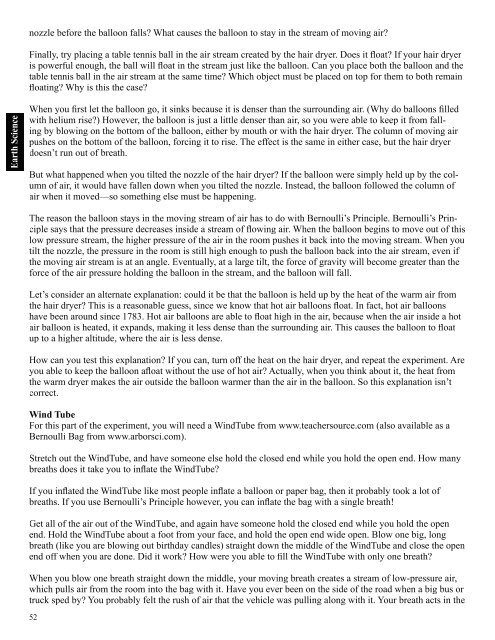ScienceMakers Toolkit Manual - The History Makers
ScienceMakers Toolkit Manual - The History Makers
ScienceMakers Toolkit Manual - The History Makers
You also want an ePaper? Increase the reach of your titles
YUMPU automatically turns print PDFs into web optimized ePapers that Google loves.
Earth Science<br />
nozzle before the balloon falls? What causes the balloon to stay in the stream of moving air?<br />
Finally, try placing a table tennis ball in the air stream created by the hair dryer. Does it fl oat? If your hair dryer<br />
is powerful enough, the ball will fl oat in the stream just like the balloon. Can you place both the balloon and the<br />
table tennis ball in the air stream at the same time? Which object must be placed on top for them to both remain<br />
fl oating? Why is this the case?<br />
When you fi rst let the balloon go, it sinks because it is denser than the surrounding air. (Why do balloons fi lled<br />
with helium rise?) However, the balloon is just a little denser than air, so you were able to keep it from falling<br />
by blowing on the bottom of the balloon, either by mouth or with the hair dryer. <strong>The</strong> column of moving air<br />
pushes on the bottom of the balloon, forcing it to rise. <strong>The</strong> effect is the same in either case, but the hair dryer<br />
doesn’t run out of breath.<br />
But what happened when you tilted the nozzle of the hair dryer? If the balloon were simply held up by the column<br />
of air, it would have fallen down when you tilted the nozzle. Instead, the balloon followed the column of<br />
air when it moved—so something else must be happening.<br />
<strong>The</strong> reason the balloon stays in the moving stream of air has to do with Bernoulli’s Principle. Bernoulli’s Principle<br />
says that the pressure decreases inside a stream of fl owing air. When the balloon begins to move out of this<br />
low pressure stream, the higher pressure of the air in the room pushes it back into the moving stream. When you<br />
tilt the nozzle, the pressure in the room is still high enough to push the balloon back into the air stream, even if<br />
the moving air stream is at an angle. Eventually, at a large tilt, the force of gravity will become greater than the<br />
force of the air pressure holding the balloon in the stream, and the balloon will fall.<br />
Let’s consider an alternate explanation: could it be that the balloon is held up by the heat of the warm air from<br />
the hair dryer? This is a reasonable guess, since we know that hot air balloons fl oat. In fact, hot air balloons<br />
have been around since 1783. Hot air balloons are able to fl oat high in the air, because when the air inside a hot<br />
air balloon is heated, it expands, making it less dense than the surrounding air. This causes the balloon to fl oat<br />
up to a higher altitude, where the air is less dense.<br />
How can you test this explanation? If you can, turn off the heat on the hair dryer, and repeat the experiment. Are<br />
you able to keep the balloon afl oat without the use of hot air? Actually, when you think about it, the heat from<br />
the warm dryer makes the air outside the balloon warmer than the air in the balloon. So this explanation isn’t<br />
correct.<br />
Wind Tube<br />
For this part of the experiment, you will need a WindTube from www.teachersource.com (also available as a<br />
Bernoulli Bag from www.arborsci.com).<br />
Stretch out the WindTube, and have someone else hold the closed end while you hold the open end. How many<br />
breaths does it take you to infl ate the WindTube?<br />
If you infl ated the WindTube like most people infl ate a balloon or paper bag, then it probably took a lot of<br />
breaths. If you use Bernoulli’s Principle however, you can infl ate the bag with a single breath!<br />
Get all of the air out of the WindTube, and again have someone hold the closed end while you hold the open<br />
end. Hold the WindTube about a foot from your face, and hold the open end wide open. Blow one big, long<br />
breath (like you are blowing out birthday candles) straight down the middle of the WindTube and close the open<br />
end off when you are done. Did it work? How were you able to fi ll the WindTube with only one breath?<br />
When you blow one breath straight down the middle, your moving breath creates a stream of low-pressure air,<br />
which pulls air from the room into the bag with it. Have you ever been on the side of the road when a big bus or<br />
truck sped by? You probably felt the rush of air that the vehicle was pulling along with it. Your breath acts in the<br />
52










